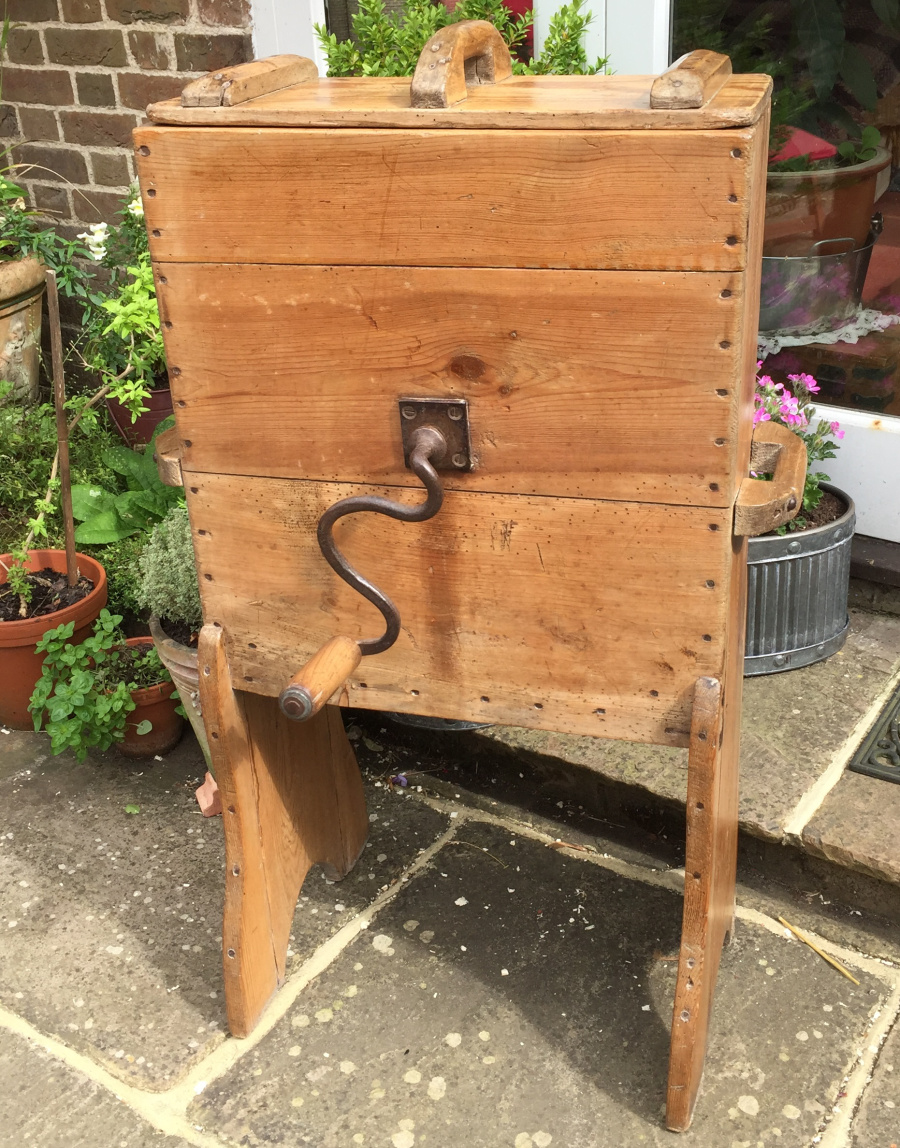The idea of a ‘separate system’ in British prisons was introduced in the 19th Century, influenced by Cherry Hill Prison in Pennsylvania, USA. It was widely believed during this period that criminals were bad because they had been open to influences that made them that way. Under this system prison inmates were kept separate and silent with only their own thoughts and the bible, in order to prevent them being influenced by one another and to promote reform through the means of spiritual renewal. The first British
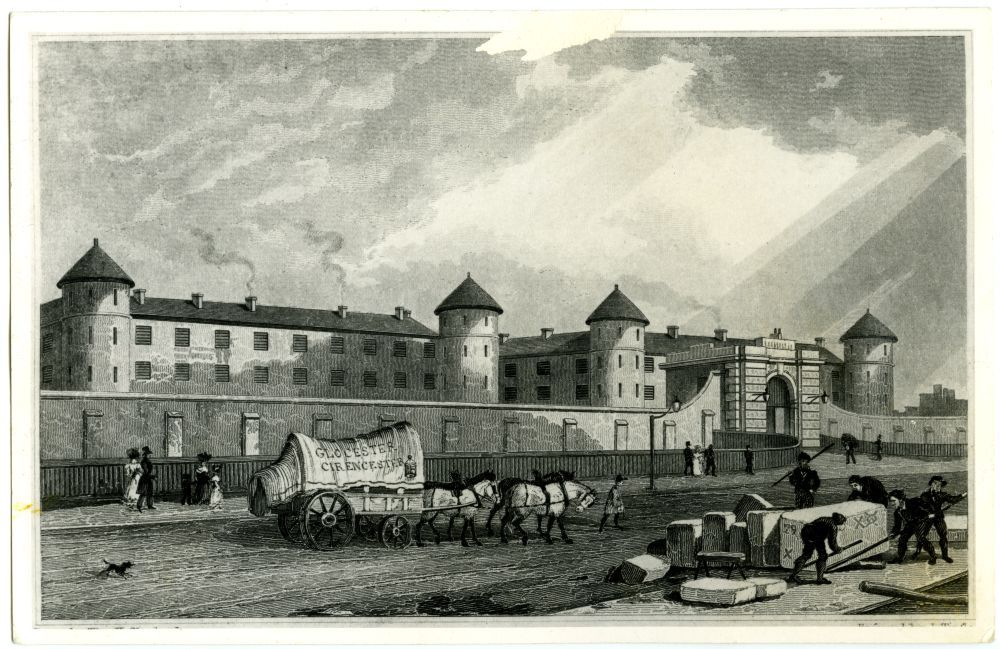 Engraving of Millbank Penitentiary, Tate Archives
Engraving of Millbank Penitentiary, Tate Archives
jails to incorporate these ideas were the convict gaols of Millbank and Pentonville, and afterwards other British prisons began to follow suit. Prisoners were expected to carry out some form of work, exercise and attend chapel, all in silence. As you would expect, inmates were not keen to conform to these rules and regulations, and communication under this system was assumed to be frequent.
Frederick Brocklehurst’s 1898 novel “I Was In Prison” gives a detailed account of his
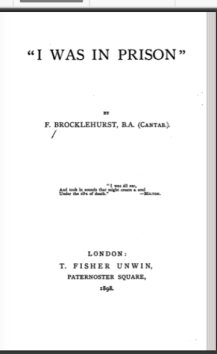 Title page from Frederick Brocklehurst’s novel “I Was In Prison” 1898.
Title page from Frederick Brocklehurst’s novel “I Was In Prison” 1898.
own prison experience and the separate system, based on the short time he spent in HMP Strangeways, Manchester. Brocklehurst’s crime was so insignificant that he was given the choice to either pay a fine or spend a month behind bars, he chose the latter. The separate system was in place for the duration of his sentence, and although this was only a short period Brocklehurst reveals how desolate and terribly lonely this enforced solitude was, he states “Imagine a blind man, denied human intercourse, with power of motion only in a space 14 feet by 7, whose only contact with a limited outside world comes through ceiling, walls and iron door” (p29) reading this from an outsiders point of view with no personal experience of prison, it would be easy to conclude that such desperate isolation would be enough deterrence to prevent prisoners from re-offending, but instead of reforming inmates and teaching them to better themselves, solitary confinement taught them to be the exact opposite.
Charles Dicken’s founded and edited the magazine Household Words in 1850, he aimed for it to reach an affluent middle class family audience as well as people of influence. In the 5th magazine that was published, Dickens criticised the treatment of criminals during this period and disagrees that the separate system was beneficial to inmates, much the same view as Brocklehurst presents in his novel. Dickens states that it “is in that constitution of human nature which impels mankind to communication with one another, and makes solitude a false condition against which nature strives.” (p101)
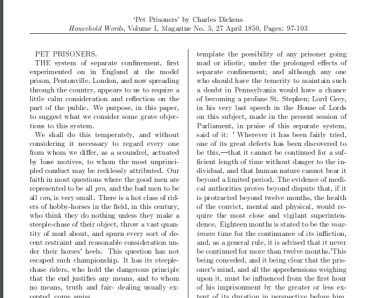 Charles Dickens 1850 article titled “Pet Prisoners” published in Household Words magazine.
Charles Dickens 1850 article titled “Pet Prisoners” published in Household Words magazine.
with this said, the idea of the separate system would never be a complete success as it is in a persons nature to communicate, and the strict rules preventing communication only made it all the more tempting for them. In reference to Millbank prison, URQ Henriques talks about the the committee asking for improvements to the prison chapel because it was too dark to see inmates well. He states that “ill-disposed prisoners pervert the time of public worship into a season not only of disorders and irregularity but of practices congenial with the darkness of their situation” (p76) it is clear from this that prisoners would attempt communication at any given opportunity if they thought they were out of the prison warders sight and from Dickens and Brocklehurst’s texts, it is evident that chapel was not the only place that gave inmates opportunity to converse.
Dickens talks of inmates throwing small pieces of paper with writing on into the apertures of cell doors, Brocklehurst reveals that messages were written on the doors of the bathroom walls, or communication would be made through the use of signals. He states that “It is a well known fact that prisoners do “communicate” with one another” (p98) this statement, combined with Dickens’ revelations of inmates communication show that it was not uncommon for these rules to be broken. Moreover, it demonstrates the difficulty warders had in ensuring that none of the offenders were communicating and the impossibility of the system working. Even in John Fields book “Prison Discipline: And the Advantages of the Separate System” reveals that the prohibition of communication “instead of preventing the evil, only induced prisoners to be more cunning in the practice of it” (p29) despite supposedly looking into the advantages of the system, this reveals one of its biggest flaws. The separate system encourages hypocrisy instead of good behaviour, rather than creating reformed members of society it instead allowed inmates to put on a facade and pretend they were adhering to the rules and regulations in order to seek redemption from prison officials and be rewarded for their good behaviour.
The separate system has a long history of use in penal systems, the method used is an attempt at reformation of inmates through enforced contemplation and exposure to good influences such as Christianity. Phillip Priestley argues in his book “Victorian Prison Lives” “so obsessed do prisoners become with their own suffering that they have no time
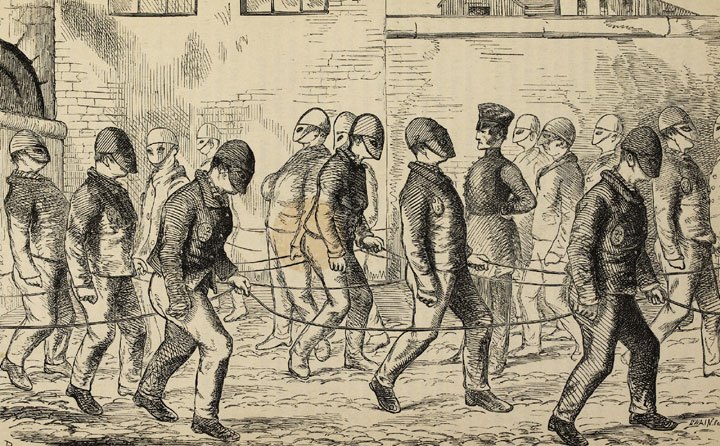 Convicts exercising in Pentonville Prison. Inmates were made to wear ‘peaks’ in order to prevent communication
Convicts exercising in Pentonville Prison. Inmates were made to wear ‘peaks’ in order to prevent communication
to consider the suffering they may have caused to others.” which suggests that although silence and isolation was a system put in place to encourage prisoners to reflect on their wrongdoings and feel remorseful, the torture of the punishment makes them feel sorry for themselves instead of those they have done wrong. Dickens appears to agree with this theory in “Pet Prisoners” stating that he feels solitary confinement encourages “A strange absorbing selfishness – a spiritual ego-ism and vanity, real or assumed.” (p100) similarly, his thoughts on the silent system are that the victims of the crimes committed by these offenders just become a part of their story, while they reflect on how sorry they feel for themselves.
Not only did the silent system not necessarily work in the way it was intended to, it was extremely damaging to the health of inmates. Senior chaplain at Pentonville, Joseph Kingsmill described how “there was an undue proportion of mental disturbance and excitement, from insanity downwards to a sort of indescribable nervous or hysterical condition” (p500) which is unsurprising given the conditions prisoners had to endure. However the rapid rise in mental illness was ignored at first, and for some time after this realisation the separate system expanded to other prisons. Even in Brocklehurst’s one month sentence in Strangeways, it is clear to see that the system had taken its toll on his health and it wasn’t until the morning of his release that he began to feel better. However he later states that his restoration to health was “more apparent than real” and it took twelve months of “travel and change to shake them off” (p133) this implies that his
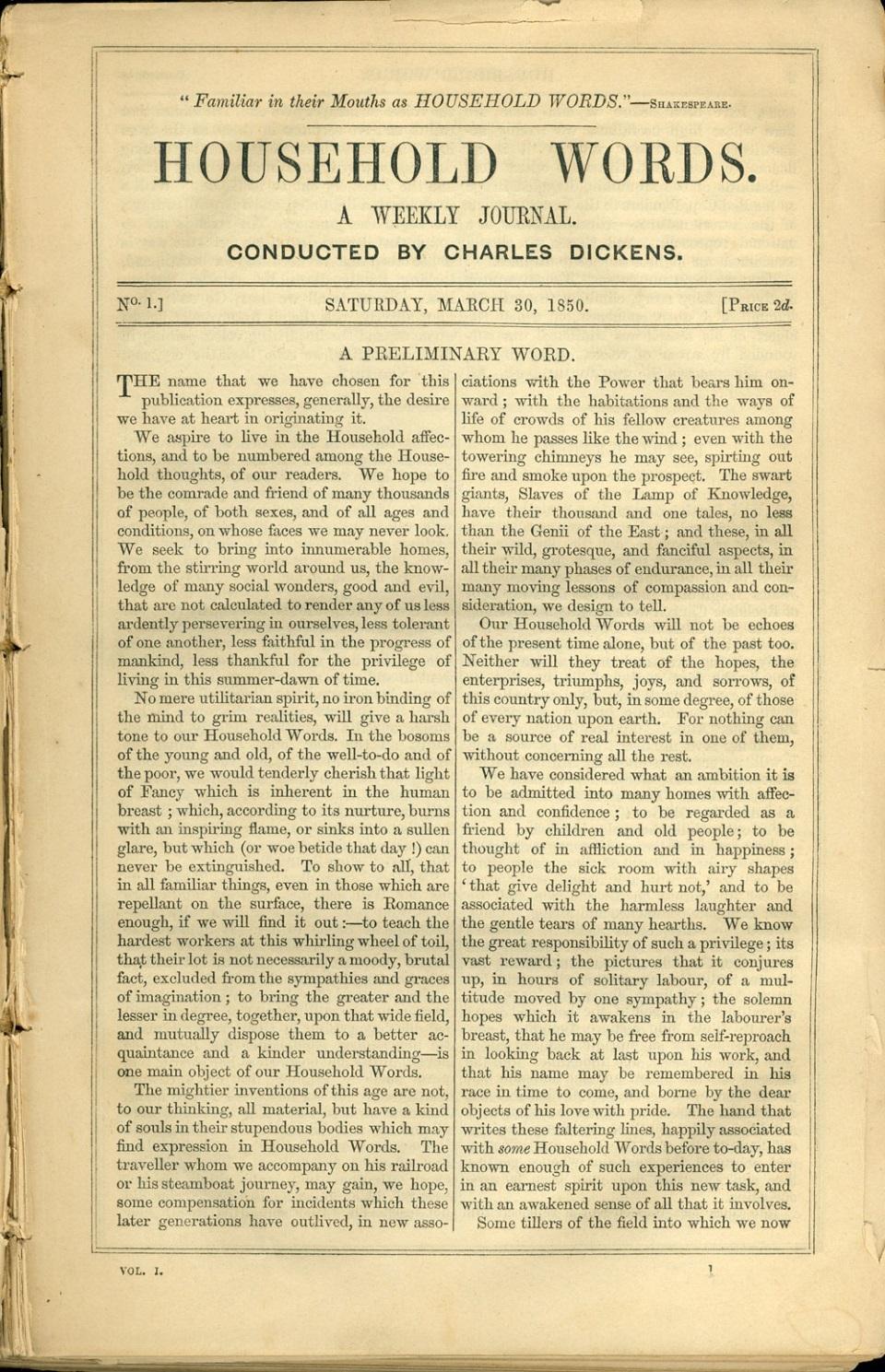 The inaugural edition of “Household Words” founded and edited by Charles Dickens (1850-59).
The inaugural edition of “Household Words” founded and edited by Charles Dickens (1850-59).
illness was more of the mind than a physical ailment. If this was the case after only a months imprisonment the impact on those subject to separate confinement for much longer periods would likely be irreparable.
Some have argued, on the other hand that separate confinement does have advantages. Dickens for example urges his readers to prefer this system as being less costly than those previously implemented. Governor of the house of correction at Brixton, John Sibly argues in his book that “even an appearance only of order and regularity is valuable in a prison no person for a moment will attempt to deny” suggesting that the routine learned in prison is one which will assist prisoners on their path to reformation. Arguments favouring the separate system however are few and far between.
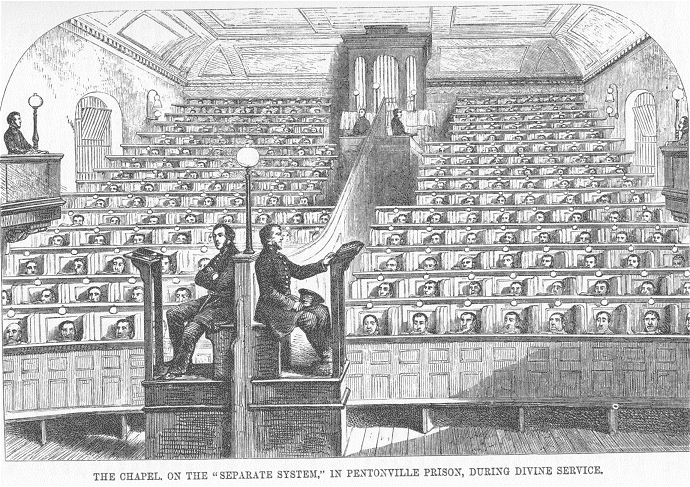 The chapel on the ‘separate system’ in Pentonville Prison, during divine service.
The chapel on the ‘separate system’ in Pentonville Prison, during divine service.
The main reason for the failure of the separate system, was that the roots of crime grew outside of the prison walls and whether this system was in place or not, this would still be the case. Moreover, it proved to be pretty much impossible to enforce separation and silence, especially as inmates always found a way around these rules. Despite punishments being in place for those who were caught communicating with other inmates, they continued to do so and the result was only that there was a very large proportion of prisoners serving punishments at once and this clearly didn’t deter them from breaking the rules.
In conclusion, I think it is fair to say that the silent system was not only extremely harsh and detrimental to prisoners mental health, there were also too many flaws in it that prison officials were unable to fix, this led to its inevitable failure. By the end of the Victorian era it started to become clear that communication could not be invariably maintained and therefore the system could no longer work.
References
Primary Sources
Brocklehurst, F “I Was In Prison” (1898) T.F Unwin, London [Online] URL: https://archive.org/stream/iwasinprison00brocgoog#page/n8/mode/2up Date Accessed: 17/01/2018
Dickens, C “Pet Prisoners” (1850) in Household Words, Volume I, Magazine No. 5, Pages: 97-103 [Online] URL: http://www.djo.org.uk/media/downloads/articles/117_Pet%20Prisoners.pdf
Date Accessed: 16/01/2018
Secondary Sources
Alber, J, and Lauterbach, F, editors. Stones of Law, Bricks of Shame: Narrating Imprisonment in the Victorian Age. Toronto; Buffalo; London, University of Toronto Press, (2009) [online]. URL: www.jstor.org/stable/10.3138/9781442689206, Accessed: 17/01/2018
Field, John, “Prison Discipline: And the Advantages of the Separate System of Imprisonment, With a Detailed Account of the Discipline Now Pursued in the New County Gaol, At Reading”, (1848), Volume I, Longman, Brown, Green and Longmans [online] URL: https://books.google.co.uk/books?id=kx1ortKBPxYC&printsec=frontcover#v=onepage&q&f=false Accessed: 16-01-2018
Henriques, URQ, “The Rise and Decline of the Separate System of Prison Discipline”
Past & Present, No. 54 (1972), pp. 61-93 Published by: Oxford University Press on behalf of The Past and Present Society Stable URL: http://www.jstor.org/stable/650199
Accessed: 16-01-2018
Priestly, P “Victorian Prison Lives” (2012) Random House, URL: https://books.google.co.uk/books?id=LRNnWWnD0ZYC&printsec=frontcover&source=gbs_atb#v=onepage&q=so%20obsessed&f=false Accessed: 16-01-2018
Sibly, J “A Letter on the Superior Advantages of Separate Confinement Over the System of Prison Discipline, at Present Adopted in Gaols and Houses of Correction: Addressed to Benjamin Hawes, Esq., M.P. and Respectfully Dedicated to the Worshipful Her Majesty’s Justices of the Peace for the County of Surrey” (1838), John Hatchard, Convict Labor, URL: https://play.google.com/books/reader?id=FMLaMNO8erwC&printsec=frontcover&output=reader&hl=en_GB&pg=GBS.PA1 Accessed: 17-01-2018
Images-
Millbank Prison – Tate Gallery Archives [online] http://www.tate.org.uk/context-comment/blogs/tate-britain-there-was-dreaded-millbank-prison Accessed: 17-01-2018
Frederick Brocklehurst “I Was In Prison” Title page – https://archive.org/details/iwasinprison00brocgoog Accessed: 17-01-2018
Charles Dickens- “Pet Prisoners” Article from “Household Words” (1850) URL- http://www.djo.org.uk/media/downloads/articles/117_Pet%20Prisoners.pdf
Accessed- 17-01-2018
Convicts exercising in Pentonville Prison, The British Library [Online] from Henry Mayhew’s, ‘The Criminal Prisons of London’, 1862. URL http://www.bl.uk/learning/images/victorian/crime/large102226.html
Accessed- 17-01-2018
Household Words, First edition, URL https://www.forbes.com/sites/startswithabang/2017/12/20/forget-a-christmas-carol-charles-dickens-and-michael-faraday-created-a-chemistry-carol/#19efa75b1347 Accessed 18-01-2018
The Chapel on the ‘Separate System’ during divine intervention – The Criminal Prisons of London and Scenes of London Life (The Great World of London), by Henry Mayhew and John Binny, 1862 http://www.victorianlondon.org/publications5/prisons-06.htm Accessed 18-01-2018
Advertisements Share this:
